Colored walls in a desert oasis: Garden of Alan Richards
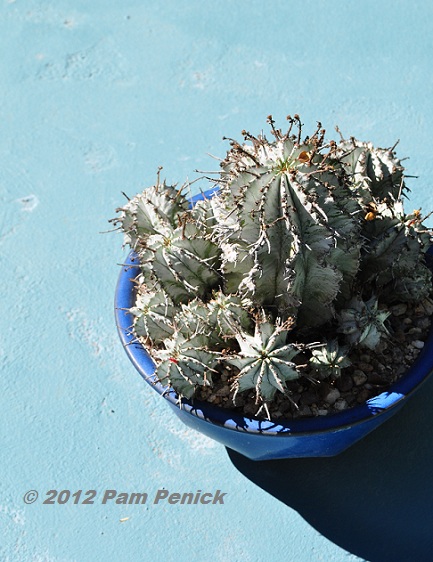
What do you expect to see when you visit a desert garden? Cactus, of course, in all its architectural, spiny splendor. I recently attended the annual Garden Writers Association Symposium, held this year in Tucson, Arizona. We were bused to three private gardens, along with various community gardens and the Tucson Botanical Garden. Boy, did they all deliver on the cactus! We saw marvelously outlandish specimens at every turn, from the iconic saguaro to rotund barrels to Mickey Mouse-eared Opuntia. It was in many ways a profoundly foreign landscape, even though we can grow many spiky species here in Austin too.
Alan Richards’s garden also delivered on something I don’t see much of in greener Austin: jolts of color on walls and benches, from the chalky hues of a box of pastels to the saturated jewel tones of a royal treasury. The intense sunlight, which so beautifully illuminates the spiny or hairy sun-protective coats on the native flora, meets its match in colors like these, which refuse to wash out or fade into the background. They look even more vibrant in contrast to the mostly evergreen plants and tan, rocky soil. Plus the stately, formidably armed plants just beg to be highlighted against a brightly colored wall. If I lived in the desert, I would definitely have a colored wall against which to show off my plants.
I can’t quite see it working in Austin, but isn’t this smashing in the bold desert garden?
This low wall functions as a bench or pedestal for a display of found art.
The front garden is enclosed by golden-yellow walls and packed densely with arid-loving plants. The floor of the garden is a sandy rock, which also makes up the paths, delineated by rounded rocks.
Juxtaposing different shapes is a time-honored design principle, and it works just as well in a desert garden.
Tucson is located in the Sonoran Desert, which is considered an arboreal and relatively lush desert. The owner and designer, Alan Richards, has planted a number of airy trees for shade and vertical interest. From the front door, you essentially view the garden through a screen of fine-textured, leafy foliage.
There’s even a tall pine tree! Not what I expected to see in the desert. How about you?
The blue, symmetrical rosette of this agave echoes the blue of the bench pillows.
Ocotillo in leaf is yellow-green, which looks lovely alongside those golden walls.
Agave, prickly pear, and a yucca-like plant that I’m not able to ID.
By the door, close to a watering can, there’s even space for colorful marigolds. They look charming in this cobalt-blue pot.
The back garden seems even more lush, and there are welcome areas of shade thanks to numerous small trees.
Sandy paths that reminded me of beach paths through dunes wind through the garden, creating an enticement to explore. The lush plants keep you from seeing everything at once.
Here and there intimate seating areas are tucked under the shade of an airy tree.
In a more open, sunny spot, columnar cactus and Opuntia frame a lovely turquoise-bowl water feature.
Scrap metal becomes sculpture, elevated by its placement atop a low wall.
Plants become sculpture too, like this stunning agave in a matching turquoise pot.
The play of light across its leaves highlights their toothy edges.
An elemental sculpture, like something Georgia O’Keeffe might have painted, is displayed on another of those fabulous colored walls.
Like javelins on a playing field, these long poles stand at angles and glint blue and gold in the sunlight. This is a sculptural work that you must walk through, placed as they are in the sandy path.
Looking more closely, you see that the necks of wine bottles have been stacked along the poles, making a sort of bottle ocotillo, rather than a bottle tree.
Another one stands behind the bowl fountain, echoing the vertical lines of the cactus.
A water feature, even a small one like this, is a welcome oasis in a desert garden. I bet birds love to bathe in it, standing on the river stones that fill most of the bowl.
Bees are happy here too.
As was I, loving the bold forms of the plants and the way the fine-textured ones hold the light.
For a look back at my first post about going to the GWA symposium, click here. Coming up next: A visit to Lorien Tersey’s DreamFlower Garden.
All material © 2006-2012 by Pam Penick for Digging. Unauthorized reproduction prohibited.


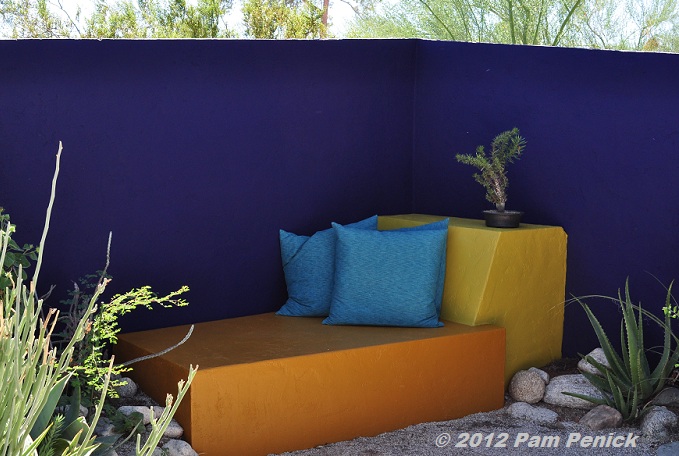
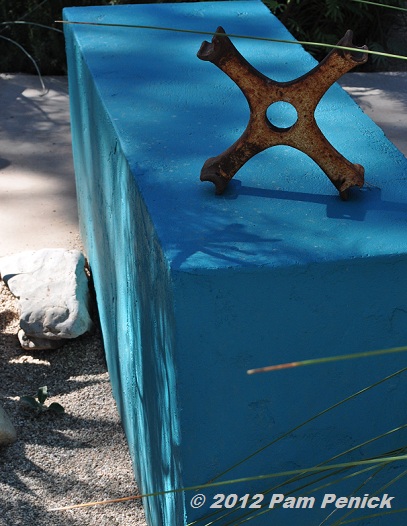
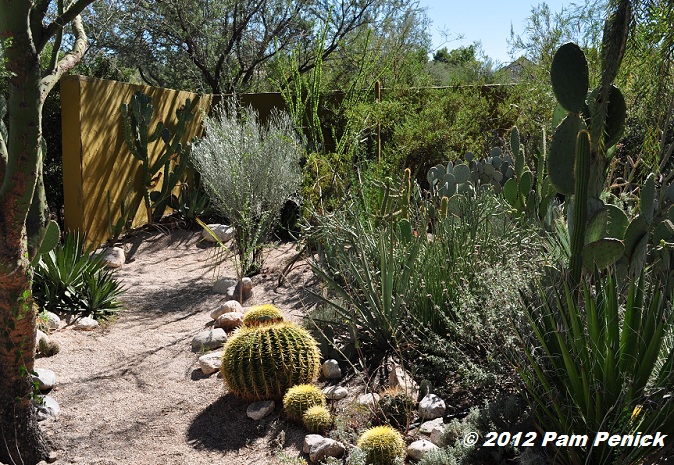
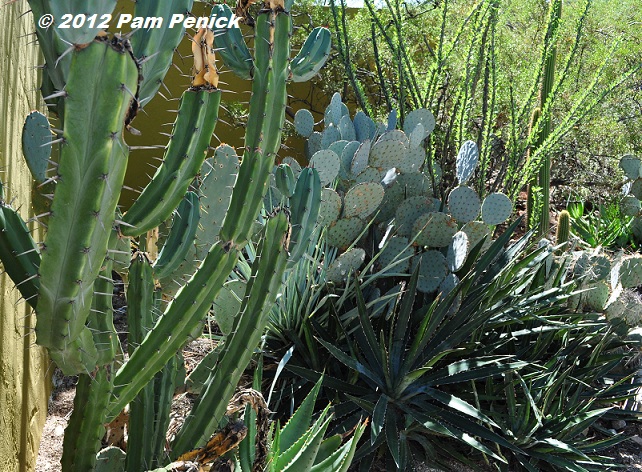
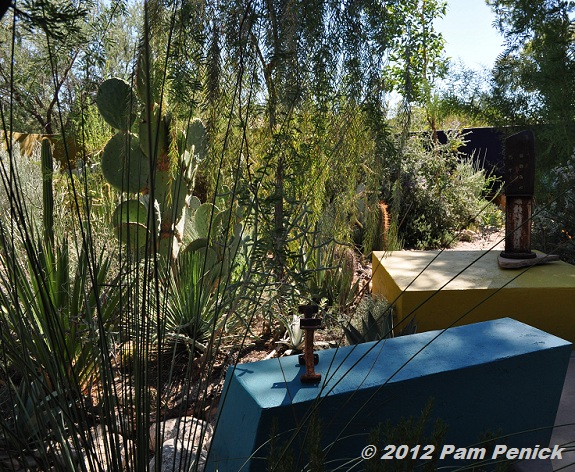
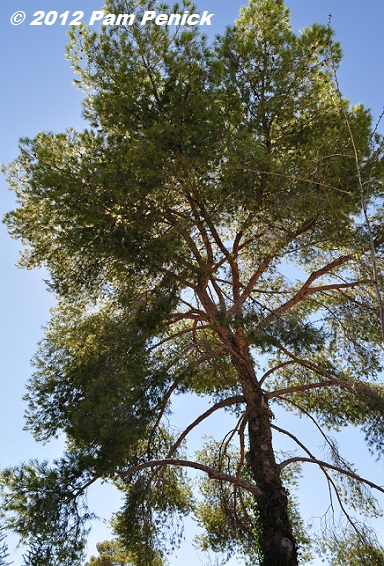
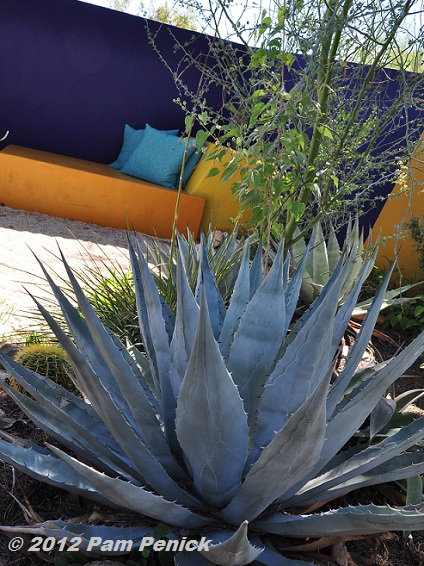
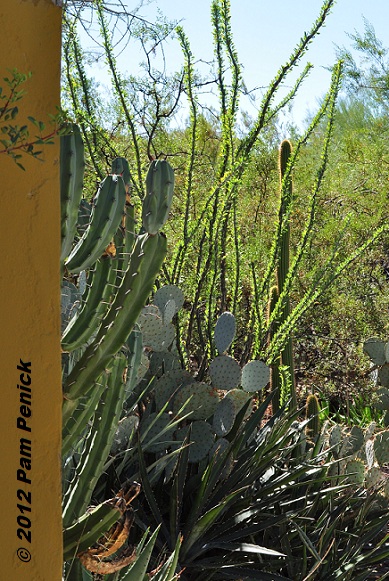
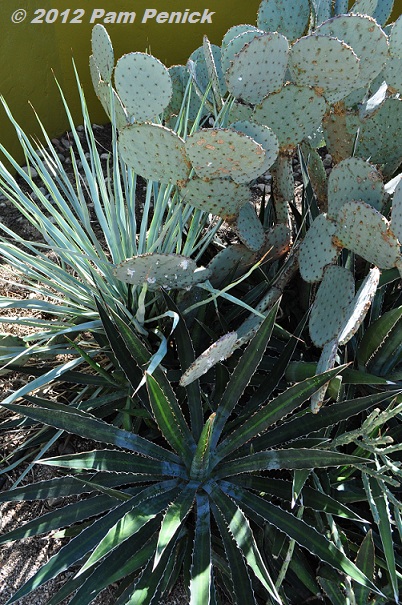
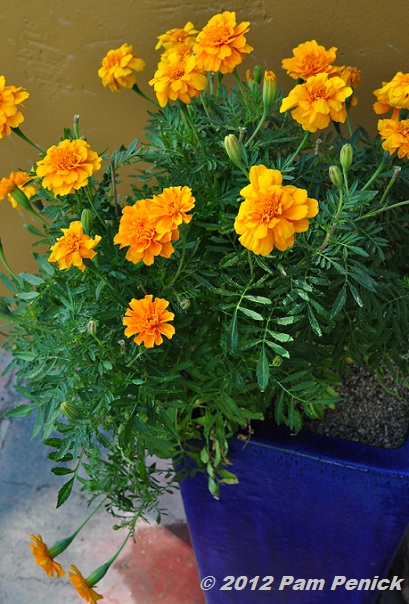
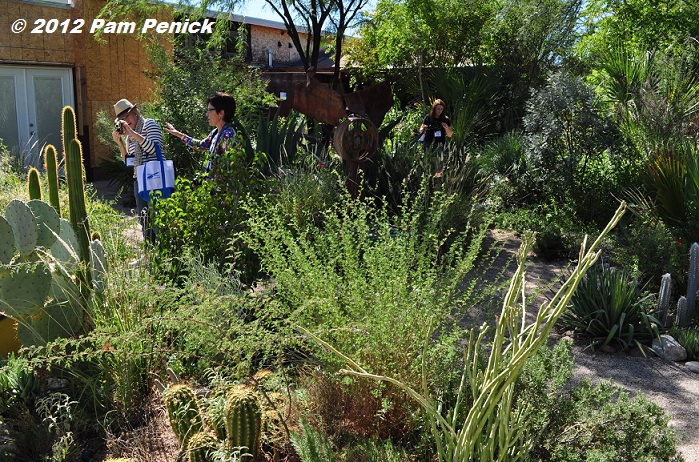
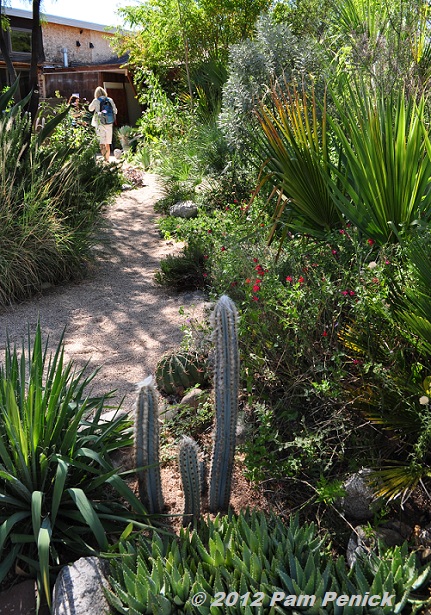
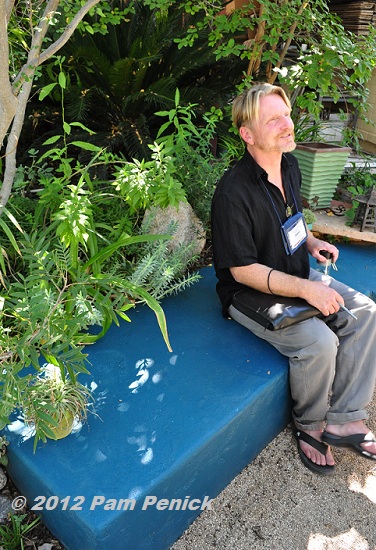
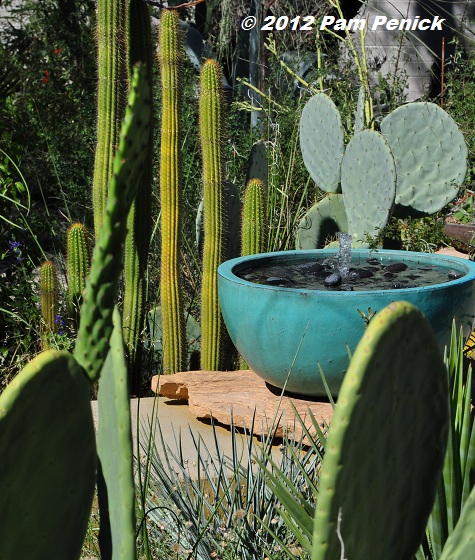
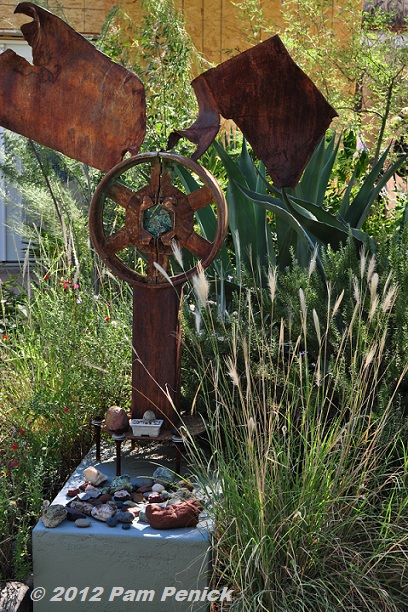
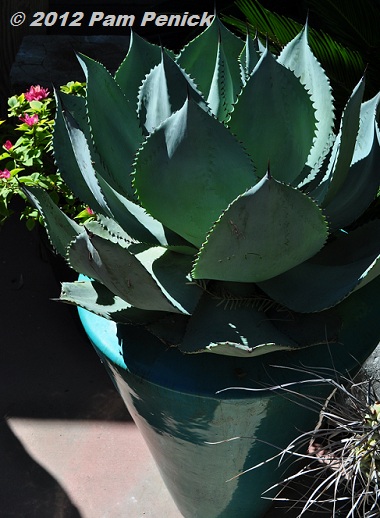
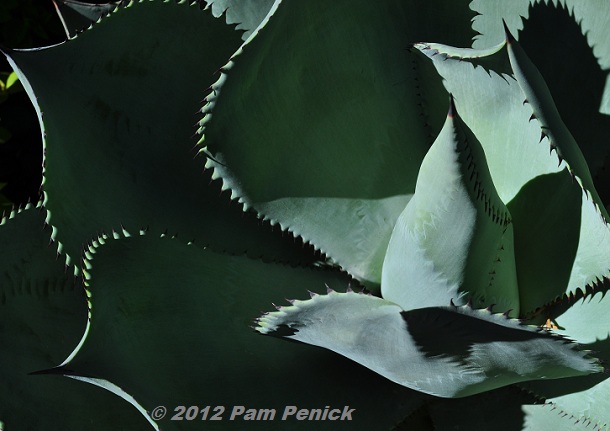
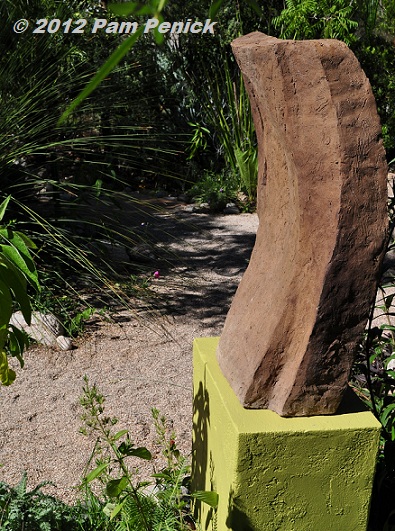
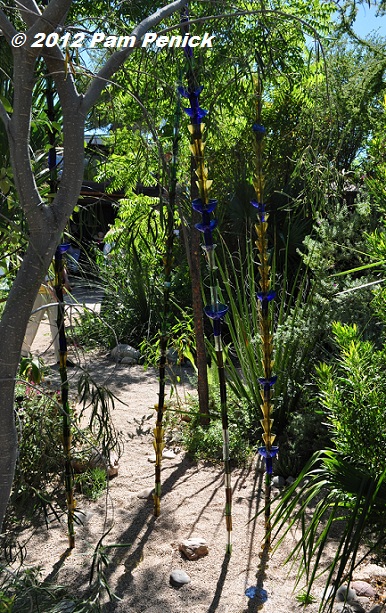
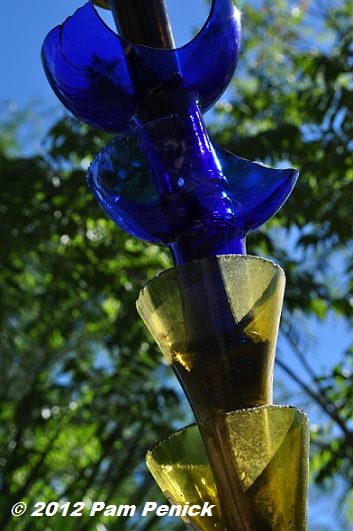
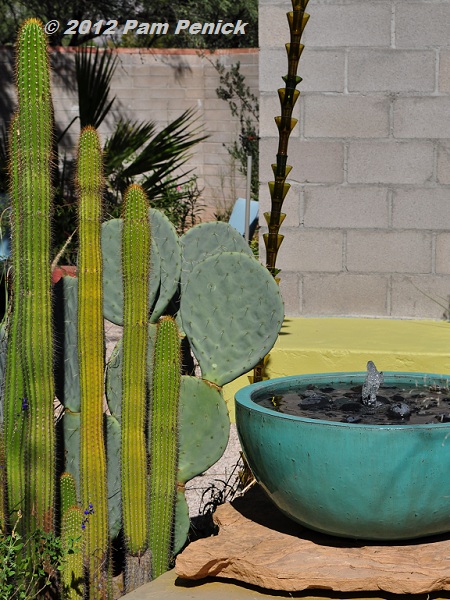
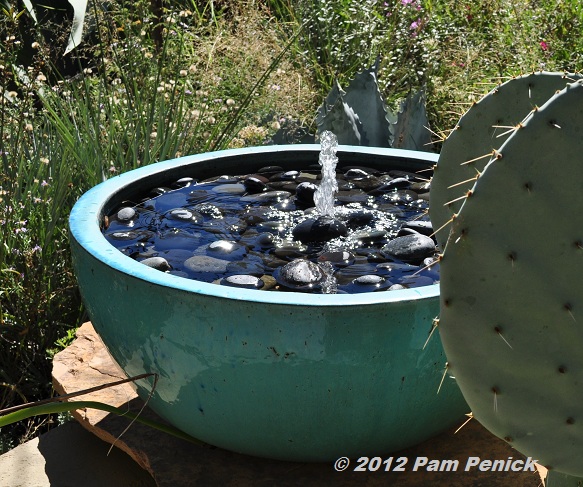
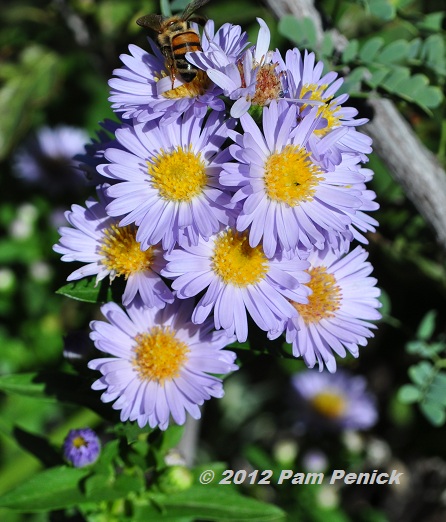
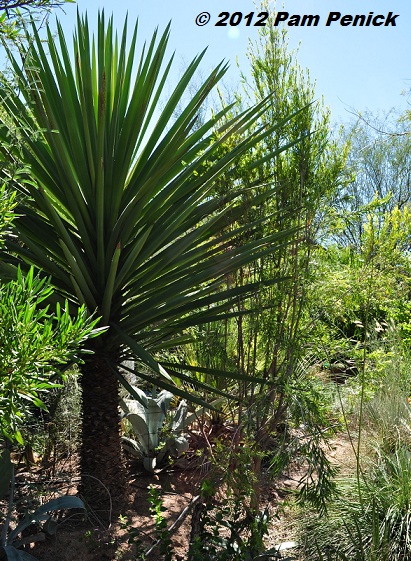
Nice job capturing the color and the sculpture in this garden. The color did give it a lush feel, in spite of the desert climate.
This was the lushest private garden we saw, don’t you think? The botanical garden had areas that felt like this too. —Pam
I didn’t think I would ever consider a desert style garden as being lush. This garden indeed seems to be lush and intriguing. The colorful walls and benches are fabulous. The pillows make the stucco (?) look comfortable.
And they add even more fun color, don’t they? I think you would have enjoyed exploring this garden, Lisa, and then you’d have even more material to paint afterward. 🙂 —Pam
What a stellar garden and my mind is already trying to work out recreating his bottle neck spears!
I was wondering how he made these too, Gail. Aren’t they fun? —Pam
Beautiful! Did you hear about Petey Mesquity, a local Tuscon radio personality who shares his love of desert plants, and animals on a show called Growing Native? He’s a Tuscon personality, a nursery owner, and is very funny. Check him out on KXCI, tuscon’s public radio station.
Not only did I hear about him, but I actually heard him speak. Petey Mesquitey was the keynote speaker at GWA, and it was one of the best talks I’ve ever heard. I’m now a huge fan! —Pam
Pam, you caught the bold colors just right! They are a different tradition than the stone and weathered wood of Austin, but they would work equally well in Austin because the sunlight is intense enough. What works against them in Austin is the aforementioned stone and wood context, but in an isolated garden…wow!
That’s a good point, Peter. We do have the stone and wood thing going on here, and I’d add steel too. But in a garden without all that going on, the colored walls would look good with our plants too. —Pam
I love the juxtaposition of that gorgeous water feature among so many spines! Beautiful garden!
That was one of my favorite vignettes too, Cat. —Pam
Thank you for a colorful dose of desert love this morning Pam. My rain soaked eyes enjoyed the tour!
You’re welcome, Loree! Glad you enjoyed it. —Pam
Great shots of a garden I mostly failed to capture well. Pines – Aleppo, Afghan and Italian Stone are quite common in all SW desert cities, not requiring much irrigation, but really need carefully use so not to detract from native, low-slung woodies. Great stuff, esp the low colored walls at different angles! The deep purple / orange / yellow wall – !!!
(caution – the Sonoran Des gets less lush and arboreal in its other areas or subdivisions, but all incredible)
Good to know, David. Is the tall pine in my picture Aleppo? —Pam
The colors are striking, and I love the water features.
I felt the same way, Jason—my two favorite features in this garden. Plus the forms of the plants against those colorful walls. —Pam
The colors, the plants, the found pieces as art all work so well together. I love the idea of lush gardens in the desert.
The broken bottle glass sculpture is a form of dangerous gardening I’d rather see in someone else’s garden.
Ha! But it goes well with the spiky plants, no? —Pam
Love this garden – so colorful and spiky and grooooovy! Although I do agree with Shirley on the broken glass….my first thought was “I want to make those!” And my second thought was…well more of a mommy nightmare with flashes of one of my kids cutting themselves badly. LOVE and appreciate this tour Pam – thank you!
I’m glad you liked it, Heather. Maybe an unbroken bottle tree would be a little safer, eh? —Pam
Gorgeous colors, but did you talk at all about the kind of paint (or other material) he uses on the stucco and concrete? I would imagine if you didn’t do it just right, you could have a maintenance mess.
No, I didn’t ask him about his paint, Cindy. —Pam
This looks like a great garden.
I like that ‘bottle ocotillo’. I couldn’t kill one of those.
I can also picture those colored walls, in a garden in South Austin. In fact, there used to be a purple house with yellow trim, right down the street from our son’s house, when he lived right off S. Congress.
Thanks for another great tour.
That’s what I say about my bottle tree, Linda: I can kill it, and it’s ever-blooming. 😉 —Pam
10th photo down, unknown yucca,,,PLEASE, if you do id it let me know. I got one as a pass-along ten years ago from a friend who found it in Colorado. Haven’t been able to find an id yet! If you want one (or more) let me know, they pup easily.
Hi, Jane. I’m sorry, but no one has offered an ID yet, and I don’t know it either. Thanks so much for offering, but I’m trying to back off of crazy pupping agaves and yuccas. I have enough pups to chase after as it is. —Pam
I just love this post and garden-the bold plants, bright colors, and especially the “bottle ocotillo’ and water feature vignette. This is definitely desert gardening at its best.
I agree, Nicole. It was my favorite private garden of the ones we visited in Tucson. —Pam
great tour! thanks! love the bold, but warm colors of the walls, and then the cool pop of aqua. that fountain is terrific. love the idea of filling low bowl with river rock. only question would be how easy it is to keep the water clean. you are right, though, the birds must love it!!
Wasn’t that rock-filled bowl a brilliant water feature idea? I imagine it could be cleaned pretty easily with a wet vac; just shove the nozzle down into the rocks and suck out the water and crud, then refill. —Pam
Thank you so much for showing us this wonderful garden. I absolutely love the color all over. I am having my house painted and am looking forward to the change in colors.
I’m having my house painted too, Candy—something besides off-white. But still fairly neutral for me because my house is not architecturally lovely. I want it to recede! —Pam
Hi Pam, it was a pleasure to have you all visit the garden! Any ?’s just let me know.
Hi, Alan! Thank you for stopping by and commenting, and most especially for opening your stunning garden to the GWA tour. Seeing your garden was a highlight of my visit to Tucson. —Pam
The mystery plant ID is sotol (Dasylirion wheeleri)
I don’t think so, Carole. It lacks the teeth along the leaves that Wheelers sotol has. It may be some other type of sotol, or possibly a yucca. —Pam